From the organizers of the Babaylan Festival, Bago City
GENERAL JUAN ANACLETO ARANETA RESIDENCE & LANDMARK MUSEUM
CORNER RIZAL & MATTI STREETS, BAGO CITY, NEGROS OCCIDENTAL, PHILIPPINES 6101
Babaylan – The Legend
Babaylan – “babai” – woman “belian” – spirits. Old woman who presided over the religious rites of the ancient times. She was “katalonan” of the old days. Since the offerers to the gods were limited to women the Babaylan is a doctor, herbalist, artist, medium, adviser, agriculturist and more all rolled in one very interesting character. They are the keeper of rituals and spirit agents in the normal world. They were held in high esteem and deference by the natives even of fear. The natives deferred to them in all ways. Their word was received with great respect and their capabilities held with awe.
There are no written records on the native religion that the Spaniards found in the Philippines. It was based on oral tradition which was passed from generation to generation through songs. They reconstructed this pre-conquest religion from beliefs and observation. These were done by chroniclers mostly missionaries and laymen who came to the Philippines and left accounts of what they saw, heard and observed.
The Babaylan phenomenon in the Philippines can be traced to antiquity. It is an integral part of the pre-Hispanic life and still survives today in many rural areas of the country. At the base of this phenomenon are animistic beliefs and practices expressed in ritual activities.
The basic idea to Babaylan is belief that certain individuals are chosen to follow a “calling” to become folk healers. In preparation of such “calling” the“chosen” people undergoes cosmic emersion a rare experience wherein the“self” gets absorbed in the cosmos or the beyond. There, the potential Babaylan gets tutored on the Babaylan craft by his ancestral spirit(s), who acts as his supernatural sponsor or spirit guide(s). This experience is repeated in the performance of rites in connection with his craft and becomes master of spirit beings. In other societies around the world cited in literatures, referred to as “Shamanism”.
Definitions and Characteristics
A Babaylan is a religio-initiated person who has undergone a deep intense spiritual experience. The successful passage of which is considered critical to his mental and physical well-being. He eventually overcomes this state resulting in his being sensitive to psychic or supernatural forces.
A Babaylan is a folk therapist, not only of physical ailments but more especially of the mental and emotional stress experienced by an individual. He employs similar method and cures (plus his own improvisations) similar to those of senior Babaylans but with guidance from them.
A Babaylan is a priest who officiates in rites involving the invoking of supernatural beings. As a “favored” person by the ancestral soul-spirits, he has a “surog”, or a spirit-guide whom he can call on during a rite to ask for assistance as in the case of diagnosing an illness. He appeases the spirits who where offended by unintended misdemeanors or intrusion to the spirit’s habitat. Rituals performed by the Babaylan are meant to be preventive or curative. Others are ceremonies pertain to passage from one stage of life to another or nourish and strengthen the soul of a living person. Also rituals are intended for a bountiful harvest and a good catch.
The Babaylan is a folk philosopher and an ideologue. He muses and ponders about the universe. He reflects on man’s physical and spiritual (or dungan – the soul or “double” of a person) composition and how it affects man’s well-being. How the soul, an entity giving man’s vitality, can be nurtured and strengthened to protect him from harm caused by environmental spirits or by the competition of the soul with others who are better protected by health-related rituals.
Babaylans are the keepers of culture. As a bearer of tradition for the community, he directly and indirectly socializes or trains initiates and potential initiates for social participation by setting up norms for others to follow. Because he invokes supernatural sanctions, members of the community comply with the tradition. Thus, he insures the recruitment of individuals to institutionalize the traditional roles resulting in the stability and endurance of the social structures.
Powers of a Babaylan
A Babaylan can communicate with ancestral and environmental spirits through a medium he alone knows. This is performed with the use of a ritual language he has mastered and by striking a metallic bell-shaped object. Chants and prayers he has, mastered also accompanied by dancing and other forms of body movements were used during rituals. Also, certain types of food are offered, ritual materials arrangements used has meaning and symbolisms for communicating with the spirit beings. His ritual garb composed of a triangular scarf and a piece of long cloth, also conveys meaning understood only in the context of the occasion. All these comprise a ritual drama meant to impress the spirit beings and to get their favor.
A Babaylan can make the supernatural spirits enter and leave his body at will. When a Babaylan asks a supernatural spirit and guide or “surog” for assistance in a certain rite, he may choose to have the spirit enter his body or simply talk to him. The body trembles or trance-like manner. This are just few manifestation that a Babaylan have been possessed by his “surog”. Acting like a deaf-mute and talking in a different tone of voice and using a language not understood by the audience are other indications of such possessions. A master of the craft can select the spirits they want to admit into their bodies.
A Babaylan can persuade back and lured or captured “dungan”. This is done by offering and thru negotiation to the enraged or hostile spirits. If all fails, he engages in a fight.
Clem del Castillo, Curator
Stephen, Assistant Curator
References:
Bisayas 1582 – 1583; Miguel de Loarca
Pigafetta
Salazar (1989)
Yamamoto
Negros Occidental History; Modesto P. Sa-onoy
The Enduring Ma-aram Tradition; Alicia P. Magos
Babaylanism in Negros; Evelyn Tan Cullamar







